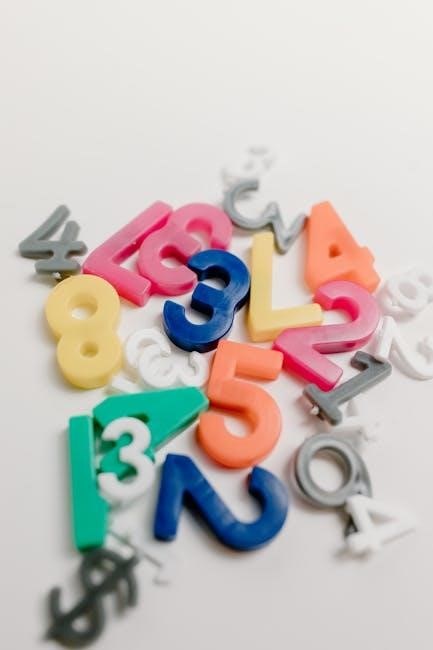
The Common Core Math Standards for Grade 6 focus on four critical areas, emphasizing problem-solving skills, ratios, fractions, and real-world applications to build a strong mathematical foundation.
Overview of the Four Critical Areas in Grade 6 Mathematics
In Grade 6, the Common Core Math Standards focus on four critical areas to ensure students develop a robust understanding of mathematical concepts. These areas include: (1) connecting ratio and rate to whole number operations, where students learn to understand and apply ratios and rates in real-world contexts; (2) extending understanding of rational numbers, which involves working with fractions, decimals, and percents to solve problems; (3) operations with fractions, emphasizing the ability to add, subtract, multiply, and divide fractions effectively; and (4) solving equations and inequalities, where students develop algebraic thinking to solve linear equations and graph inequalities. These areas are designed to prepare students for higher-level mathematics by fostering problem-solving skills and mathematical reasoning.

Ratios and Rates
Ratios and rates are introduced to connect with whole number operations, emphasizing real-world applications and problem-solving. Students learn to use ratio language, create equivalent ratios, and calculate unit rates accurately.
Understanding the Concept of Ratios
Ratios introduce students to comparing quantities, emphasizing the relationship between two numbers. Grade 6 math begins with defining ratios using symbols (e.g., a:b) or fractions. Visual models and real-life examples help students grasp how ratios represent parts of a whole or compare quantities. Instruction focuses on expressing ratios in simplest forms and identifying equivalent ratios. Students connect ratios to multiplication and division, building foundational skills for proportional reasoning. This understanding is crucial for solving real-world problems and prepares students for more complex concepts like rates and proportional relationships in later grades. By exploring ratios, students develop critical thinking and problem-solving abilities essential for advanced mathematics.
Using Ratio Language to Describe Relationships
Grade 6 students learn to articulate ratio relationships using precise language and mathematical terms. This involves identifying the parts being compared and expressing ratios in words, symbols, or fractions. For example, describing a ratio of boys to girls in a class as “3 to 4” or “3:4”. Emphasis is placed on interpreting ratios contextually, such as understanding that a ratio of 2:5 (part:whole) differs from 2:5 (part:part). Students also practice creating verbal descriptions from ratio expressions and vice versa, enhancing their communication skills. This conceptual understanding ensures they can interpret and convey ratio relationships accurately in various scenarios, a skill vital for problem-solving and higher-level mathematics.
Creating Tables of Equivalent Ratios
Students in Grade 6 learn to create tables of equivalent ratios to explore and understand proportional relationships. Equivalent ratios are pairs of numbers that express the same relationship, such as 2:4 and 3:6. By organizing these ratios in a table, students can visualize patterns and scaling factors. For example, starting with a ratio of 1:2, students can extend it by multiplying both terms by the same number to generate equivalent ratios like 2:4, 3:6, and 4:8. This process helps students recognize that ratios can be scaled up or down while maintaining their proportional relationship. Creating tables also supports real-world applications, such as mixing ingredients or comparing distances, and reinforces the concept of proportionality in mathematical problem-solving.
Calculating Unit Rates
Calculating unit rates is a foundational skill in Grade 6 math, emphasizing understanding of ratios and proportional relationships. A unit rate represents the ratio of two quantities where one of the quantities is 1. For example, if a car travels 150 miles in 5 hours, the unit rate is 30 miles per hour. Students learn to simplify complex ratios into unit rates by dividing both terms by the same factor. This skill is essential for real-world applications, such as determining cost per item, speed, or work rates. Instruction focuses on identifying unit rates from tables, word problems, and graphs, ensuring students can interpret and communicate these rates clearly. Mastery of unit rates prepares students for more advanced concepts in proportional reasoning and problem-solving.

The Number System
Grade 6 students extend their understanding of rational numbers, including fractions, decimals, and negative numbers, to solve problems and perform operations with precision and accuracy.
Extending Understanding of Rational Numbers
Grade 6 students expand their knowledge of rational numbers, exploring fractions, decimals, and percentages. They learn to identify equivalent fractions, compare fractions by converting them to decimals, and simplify complex fractions. Instruction focuses on understanding the concept of fractions as division of whole numbers, applying this to solve real-world problems. For instance, students might calculate the cost of items priced per pound or determine distances on a map using scale factors. Negative numbers are also introduced, with an emphasis on their placement on the number line and operations involving absolute values. This foundational understanding prepares students for advanced mathematical concepts in higher grades, ensuring they can manipulate and interpret rational numbers confidently.
Adding, Subtracting, Multiplying, and Dividing Fractions
In Grade 6, students master operations with fractions, including addition, subtraction, multiplication, and division. They learn to add and subtract fractions by finding common denominators, simplifying results, and solving word problems. Multiplication of fractions involves understanding the concept of multiplying numerators and denominators separately. Division of fractions is introduced through the concept of multiplying by the reciprocal, with practical applications in real-world scenarios. Visual models and real-life examples reinforce these skills, ensuring students can apply fraction operations confidently across various contexts.
Converting Between Fractions, Decimals, and Percents
Grade 6 students learn to convert between fractions, decimals, and percents, building a strong foundation in rational numbers. They understand that fractions can be expressed as decimals by dividing the numerator by the denominator and as percents by multiplying the decimal by 100. For example, 3/4 equals 0.75, which is 75%. Conversely, students learn to convert decimals to fractions by writing the decimal as a fraction over 1 and simplifying, such as 0.5 becoming 1/2. Percents are converted to fractions by dividing by 100 and simplifying, like 25% becoming 1/4. These conversions are applied in real-world contexts, such as calculating discounts or scaling recipes. Mastery of these skills enhances students’ ability to work with data and solve practical problems efficiently.
Understanding Negative Numbers
In Grade 6, students develop an understanding of negative numbers, exploring their meanings, uses, and operations. They learn that negative numbers are less than zero and can represent temperatures below freezing, financial debts, or positions on a number line. Students visualize negatives on a number line, recognizing symmetry with positives and absolute value concepts. They practice comparing and ordering negatives, understanding that -5 is less than -3. Operations with negatives are introduced, starting with addition and subtraction, such as (-2) + (-3) = -5 and (-1) ౼ (-4) = 3. Multiplication and division of negatives are also covered, with a focus on rules like a negative times a negative equals a positive. These skills are applied in word problems, such as calculating temperatures dropping or financial losses, preparing students for algebraic expressions and equations in higher grades.

Operations with Fractions
Grade 6 focuses on performing operations with fractions, including addition, subtraction, multiplication, and division. Students solve word problems involving fractions and interpret quotients of fractions.
Adding and Subtracting Fractions

Grade 6 students learn to add and subtract fractions by finding common denominators, simplifying results, and applying these skills to real-world problems. They explore fraction operations using visual models like diagrams and number lines to build conceptual understanding. Emphasis is placed on solving word problems involving fractions and interpreting results. Students also convert between improper and mixed numbers to facilitate calculations. The standards encourage the use of mathematical reasoning and problem-solving strategies to ensure mastery of fraction operations. By focusing on both procedural fluency and application, students develop a strong foundation for advanced mathematics.
Multiplying and Dividing Fractions
In Grade 6, students master multiplying and dividing fractions, building on their understanding of fraction concepts. They learn to multiply fractions by whole numbers and other fractions, using visual models and algorithms. Division of fractions is introduced through real-world applications, emphasizing the concept of dividing a fraction by another. Students simplify results and interpret quotients in practical contexts. The standards highlight the importance of using mathematical reasoning and problem-solving strategies to ensure fluency in fraction operations. By focusing on both procedural skills and application, students gain confidence in handling complex fraction problems, preparing them for advanced mathematical challenges. This foundational knowledge is critical for future success in algebra and higher-level mathematics.
Solving Word Problems Involving Fractions
Grade 6 students engage in solving word problems that incorporate fractions, enhancing their ability to apply mathematical concepts to real-life scenarios. These problems often involve multi-step operations, such as adding, subtracting, multiplying, and dividing fractions. Students learn to identify key information, set up equations, and interpret results. The standards emphasize the use of visual aids, like diagrams and models, to aid comprehension. Word problems cover various contexts, including cooking, construction, and financial calculations, making learning practical and relatable. By focusing on both procedural accuracy and conceptual understanding, students develop the skills to tackle complex, open-ended problems. This approach ensures they can reason mathematically and communicate their problem-solving processes effectively, aligning with the Common Core’s emphasis on critical thinking and application.
Interpreting Quotients of Fractions
Grade 6 students learn to interpret quotients of fractions, understanding the meaning of division in various contexts. They explore how dividing by a fraction can result in a whole number, a fraction, or another type of quotient. Visual models, such as area diagrams and number lines, are used to represent these operations, helping students conceptualize the division process. Word problems are incorporated to apply these skills practically, such as determining how many groups of a certain fraction can be made from a given quantity. This understanding enhances their ability to solve real-world problems involving division of fractions by fractions, ensuring they can explain their reasoning and interpret results accurately. The focus is on both procedural fluency and conceptual understanding, aligning with the Common Core’s emphasis on deep mathematical insight.

Equations and Inequalities
Grade 6 students solve equations with variables on both sides and graph inequalities on number lines. They explore relationships between equations and their graphical representations, enhancing algebraic reasoning and problem-solving skills.
Solving Equations with Variables on Both Sides
Grade 6 students learn to solve equations where variables appear on both sides. They apply inverse operations and properties of equality to isolate variables. For example, solving 3x + 2 = 3x ⸺ 5 involves recognizing that subtracting 3x from both sides eliminates the variable, leading to a true statement. This skill develops algebraic reasoning and prepares students for more complex equations. They also practice justifying each step, ensuring a deep understanding of equality maintenance. Such problems build foundational algebra skills, essential for higher-level math.
Graphing Inequalities on a Number Line
In Grade 6, students learn to graph inequalities on a number line, visualizing solutions to inequalities like x ≤ 5 or x > -3. They use open or closed circles to represent boundary points and arrows to show the solution direction. For compound inequalities, such as -2 < x ≤ 7, students shade the interval between the endpoints. This skill helps students interpret and compare inequalities, understanding their relationships. Graphing reinforces the concept of inequality solutions as ranges of values rather than single points. It also prepares students for solving and graphing more complex inequalities in higher grades, connecting to real-world applications and algebraic reasoning.
Understanding Relationships Between Equations and Graphs
In Grade 6, students explore the relationship between linear equations and their graphical representations. They learn that equations like y = mx + b correspond to straight lines on a graph, where m represents the slope (steepness) and b is the y-intercept (starting point). By analyzing graphs, students identify key features such as slope, intercepts, and direction, and connect them to the equation’s components. Conversely, they translate equations into graphs by plotting points and drawing lines. This skill helps students visualize how changes in an equation affect its graph, fostering a deeper understanding of linear relationships. Real-world applications, such as modeling distance over time, further reinforce this concept, preparing students for more advanced algebraic studies.

Geometry
Grade 6 geometry focuses on calculating perimeter, area, and volume, exploring surface areas of 3D shapes, and applying area formulas to solve real-world problems.
Calculating Perimeter, Area, and Volume
Grade 6 students learn to calculate perimeter, area, and volume, applying mathematical formulas to solve problems. Perimeter involves adding all sides of a shape, while area requires multiplying length and width. Volume, for 3D objects, involves multiplying length, width, and height. Students practice these skills with various shapes, including composite figures. Real-world applications, such as designing rooms or packaging, help students understand practical uses of these concepts. The Common Core Standards emphasize problem-solving and critical thinking in geometry, ensuring students can apply these skills effectively in diverse scenarios.
Surface Area of Three-Dimensional Shapes
In Grade 6, students learn to calculate the surface area of various three-dimensional shapes, such as prisms, pyramids, and cylinders. Surface area is the total area of all exposed faces of a solid figure. For example, the surface area of a rectangular prism is calculated by finding the area of each face and summing them up, using the formula (2(lw + lh + wh)), where (l), (w), and (h) represent length, width, and height. Students also explore surface area in composite shapes by breaking them into simpler components. Understanding surface area is crucial for real-world applications, such as determining material costs for construction or packaging. Common Core Standards emphasize conceptual understanding and problem-solving, ensuring students can apply these skills effectively in diverse mathematical and practical scenarios.
Understanding and Applying Area Formulas
In Grade 6, students develop the ability to calculate the area of various shapes using specific formulas. They learn to apply the area formula for triangles, (base × height) ÷ 2, and extend this understanding to other polygons, such as parallelograms and trapezoids. For rectangles, students use the formula (length × width) and recognize its application in real-world problems, like calculating the area of a room or garden.
The Common Core Standards emphasize understanding rather than memorization, encouraging students to derive formulas and justify their reasoning. For example, students explore how the area of a parallelogram relates to the base and height, even when the shape is not a rectangle. This conceptual foundation prepares students for more complex geometry in higher grades and fosters problem-solving skills in practical scenarios.

Data Analysis
Students learn to summarize and analyze data using measures of central tendency (mean, median, mode, range) and create histograms, box plots, and scatter plots to display data effectively.
Measures of Central Tendency (Mean, Median, Mode, Range)
Grade 6 students explore measures of central tendency, including mean, median, mode, and range. The mean is the average of a dataset, calculated by summing all values and dividing by the number of values. The median is the middle value when data is ordered, while the mode is the most frequent value. The range is the difference between the highest and lowest values. Understanding these concepts helps students summarize datasets, identify trends, and make informed decisions. They apply these measures to real-world problems and compare their interpretations with graphical representations, fostering a deeper understanding of data analysis and statistical reasoning. This foundation is crucial for advanced mathematics and real-life applications.
Displaying Data with Histograms, Box Plots, and Scatter Plots
Grade 6 students learn to visually represent data using histograms, box plots, and scatter plots. Histograms show the distribution of data across intervals, helping to identify patterns and frequency. Box plots, or box-and-whisker plots, summarize data by displaying the median, quartiles, and outliers, providing a clear view of data spread. Scatter plots illustrate relationships between two variables, revealing trends or correlations. These tools enhance data interpretation and analysis skills, allowing students to communicate insights effectively. By creating and interpreting these graphs, students develop a deeper understanding of data representation and its practical applications in real-world scenarios, preparing them for more complex statistical studies in higher grades.

Analyzing and Summarizing Data Sets
Grade 6 students learn to analyze and summarize data sets by identifying central tendencies and variability. They calculate measures such as mean, median, mode, and range to describe data distributions. Students also interpret data by identifying patterns, outliers, and trends within a set. Summarizing data involves organizing information into clear and concise formats, such as tables or charts, to highlight key findings. These skills help students draw meaningful conclusions and communicate insights effectively. By focusing on data analysis, students develop problem-solving abilities and apply mathematical concepts to real-world scenarios, preparing them for more complex statistical studies in higher grades.

Implementation and Resources
Implementation of Common Core Math Standards in Grade 6 involves professional development for teachers and access to resources like Illustrative Mathematics and online tools to support student learning.
Best Practices for Teaching Common Core Math in Grade 6
Effective teaching of Common Core Math in Grade 6 involves using problem-solving approaches, real-world applications, and differentiated instruction. Teachers should emphasize conceptual understanding and procedural fluency. Incorporating visual models, such as tape diagrams and fraction bars, helps students grasp complex concepts. Encouraging collaborative learning and discussions fosters critical thinking and communication skills. Formative assessments, like exit tickets and quizzes, allow teachers to monitor progress and adjust instruction. Integrating technology, such as math apps and online resources, engages students and provides personalized practice. Professional development and collaboration among teachers are essential for aligning instruction with standards. By focusing on depth over breadth and promoting math literacy, educators can ensure students meet Grade 6 Common Core Math Standards.
Available Resources for Teachers and Students
A variety of resources support the implementation of Grade 6 Common Core Math Standards. Teachers can utilize professional development tools, such as workshops and online courses, to enhance their instructional strategies. Illustrative Mathematics offers a free, comprehensive curriculum for grades 6-8, providing lesson plans and activities aligned with the standards. Students benefit from interactive math apps like Khan Academy and IXL, which offer personalized practice. Additional resources include plain-English explanations of the standards and teaching tools, such as manipulatives and digital simulations, to aid in conceptual understanding. These resources help bridge gaps between teaching and learning, ensuring both educators and students have the support needed to succeed. By leveraging these tools, classrooms can effectively align instruction with the Common Core Math Standards.
The Impact of Common Core on Mathematics Education
The Common Core State Standards Initiative has significantly influenced mathematics education, introducing a unified framework for teaching and learning. By focusing on critical areas like ratios, fractions, and problem-solving, it aims to deepen students’ mathematical understanding. The standards emphasize real-world applications, fostering critical thinking and preparing students for higher-level mathematics. While some educators praise the initiative for aligning curriculum across states and providing clear goals, others criticize its complexity and the challenges it poses for parents. Despite debates, Common Core has reshaped how math is taught, encouraging a shift from rote memorization to conceptual mastery. Its implementation has also sparked the development of new resources and tools, benefiting both teachers and students in navigating the evolving educational landscape. Overall, Common Core continues to be a pivotal force in modern mathematics education.